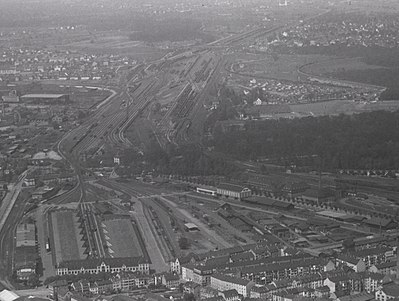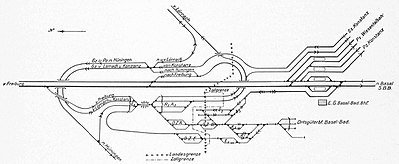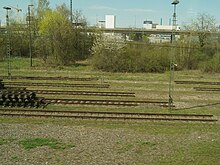Basel Bad Bf
| Basel Bad Rbf DUSS Terminal Basel - Weil am Rhein |
|
|---|---|
| Data | |
| Location in the network | Transshipment station |
| abbreviation | RBA |
| location | |
| City / municipality | Because on the Rhine |
| country | Baden-Württemberg |
| Country | Germany |
| Coordinates | 47 ° 35 '22 " N , 7 ° 36' 21" E |
| Railway lines | |
| Railway stations in Baden-Württemberg | |
The marshalling yard Basel Bad Bf ( Basel Bad Rbf ) was a marshalling yard in Basel, Switzerland and Weil am Rhein in Germany . It was closed in the 1990s. A container transshipment station was opened on the site in 1999 , today the DUSS Terminal Basel - Weil am Rhein . It is a transshipment terminal for container traffic, which can be used as a whole train and is one of the eleven major hubs of the DB subsidiary DUSS ( Deutsche Umschlaggesellschaft Schiene-Straße )
The marshalling yard (unofficially: marshalling yard Weil am Rhein , marshalling yard Basel-Weil ) in the South Baden town of Weil was opened in 1913, which made as a result the town into an industrial center. Part of the station was in Weil am Rhein, Germany, and another in Basel, Switzerland . To the north of the marshalling yard are Haltingen station and the Haltingen depot, to the east is the Weil am Rhein passenger station , and to the south of Basel Badischer Bahnhof and the former freight yard .
Today's transshipment station, located in the border area between Germany, Switzerland and France, is located on the north-south rail axis Frankfurt-Basel and is thus connected to the northern Italian industrial centers. The DUSS Terminal is an important logistical hub for transalpine freight traffic to and from Switzerland. Together with the Rheinhafen Weil am Rhein , it also offers the option of changing to feeder traffic .
history
Basel-Weil railway junction
In the course of the relocation of the first Baden train station , which was then located at today's model fair , the most expensive and extensive train station of the Grand Ducal Baden State Railways was built with an investment volume of 53.1 million Reichsmarks . The new Badischer Bahnhof was opened on September 13, 1913. In the course of the plans, the old train station in Weil-Leopoldshöhe was completely redesigned. The newly built Weil-Leopoldshöhe station was put into operation on November 20, 1911.
The freight yard of the Badischer Bahnhof was opened on December 15, 1905.
In 1909, the Badische Staatsbahn submitted the corresponding plans to the Swiss authorities, which planned a four kilometer long and 200 meter wide marshalling yard between the Wiese and Haltingen . The station was referred to in the contracts for the marshalling yard that had to be concluded between Germany and Switzerland as the Basel Badischer shunting yard .
In 1913, the station area of the three Baden railway stations in Basel and Weil, with a total of 235 hectares, was shared by Switzerland with 98 hectares and the state of Baden with 137 hectares in the communities of Haltingen and Weil. A total of 191 kilometers of track and 835 switches were laid for the construction of the one-sided marshalling yard with a working direction north> south, and 652,000 cubic meters of rubble, gravel and sand were removed from the gravel terraces and transported to the lower-lying area near Basel. To realize the facilities, 17 railway bridges, five road bridges and several tunnels had to be built. In addition to the usual components of a marshalling yard: entry group, direction group and exit group, in addition to other track groups for subsequent sorting, systems for the customs authorities in Germany and Switzerland were also set up to handle cross-border traffic. The facility as a one-sided marshalling yard necessitated the construction of three turning loops. The northern loop, still in use, served to feed the trains coming from the south (Switzerland) and east (Upper Rhine) to the entry group to the north, while the disused southern loop on Swiss territory led the departing trains to the north (Upper Rhine) and east. Another loop in the northwest led groups of wagons from the freight yard to the approach group.
In addition, a depot with a locomotive shed for 32 locomotives and corresponding workshops was built in Haltingen. Housing estates for employees of the railway, their relatives and pensioners were built in Weil. Many moved from Basel to Weil. Another railroad workers' settlement was built in Haltingen; it is the Im Rad area , which is surrounded by the northern loop and forms a circle when viewed from the air. At times, up to 10,000 railway employees lived at the Basel-Weil railway junction.
In addition to a new freight hall, a second station building was built in Haltingen for the Haltingen Süd stop on the St. Ludwig-Leopoldshöhe railway line. The halt only existed from 1911 to 1922. It was also called "Süd-Bahnhof".
- Former railway junction Basel-Weil

The railway junction was important as an end point and border station for goods traffic to Switzerland on the Baden main line from Mannheim or Constance . The Wiesentalbahn , the Leopoldshöhe – Lörrach line and the St. Ludwig – Leopoldshöhe line via Weil am Rhein were also connected. The latter was important for freight traffic from the realm of Alsace-Lorraine . After its closure in 1937, the port railway to the new Rheinhafen Weil am Rhein was connected via this branch in 1938 .
The railway junction comprised:
- Basel Badischer Bahnhof , opened in 1913 - in operation in 2017
- Weil-Leopoldshöhe station , rebuilt in 1911 - operational in 2017
- Weil-Ost station, closed in 1977, reactivated for the Basel S-Bahn (line S5)
- Haltingen station, expanded until 1913 - in operation in 2017
- Haltingen Süd stop, 1911–1922
- Basel Bad Rbf, opened in 1913 - closed; since 1999 transshipment station / DUSS terminal
- Basel Bad Gbf , opened in 1905 - closed and built over
- Haltingen depot , opened in 1913 - in operation in 2017
Basel Badischer marshalling yard
On September 15, 1913, the first section of the new marshalling yard (shunting yard ) was put into operation, followed by the second and last construction section on October 1 and 16, 1913. The station was considered a European model facility. The track loops, the so-called "eight loop", in the north (Haltingen) and in the south were traversed by the trains to be shunted in one direction.
The capacity of the marshalling yard was 3,000 wagons a day, from which around 85 trains could be formed every day. The 2.2 kilometer long port railway Kleinhüningen has been connecting the marshalling yard with the Swiss Rhine port of Kleinhüningen since 1922 . These trains are now shunted in the Muttenz marshalling yard.
Redesign to a transshipment station

With the construction of a modern push-button interlocking system in Weil am Rhein in the summer of 1985 and a track diagram interlocking in the Basel passenger station, the old interlockings between Haltingen and Weil became obsolete.
In the course of the concentration on the Mannheim and Muttenz marshalling yards after 1987, the importance declined and the marshalling yard was closed. In addition to the relocation to Muttenz station, the number of block trains also increased, so that the number of wagons shunted decreased noticeably from 2,700 to 700 to 900 per day. For these reasons, the Karlsruhe Federal Railway Directorate submitted a report to the Deutsche Bundesbahn (DB) in August 1988 on the framework planning for the Basel Badischer Bahnhof marshalling yard and freight yard, which essentially contained four points. Firstly, the already reduced track systems should be a new operational division of tasks between DB and SBB. Second, the transshipment station for combined freight traffic (KLV) was to be relocated from the freight yard to the site of the marshalling yard. Third, it was planned to build a freight center for the KLV to replace the transshipment halls. Fourthly, the areas freed up should be used by private, rail-related third-party users, e.g. B. Forwarding companies, are made available. An originally planned rolling road was rejected for technical reasons. Without the equipment for the forwarding agents, the total of all planned measures was estimated at an investment of 70 million DM .
On the largely derelict railway site in Basel and Weil am Rhein, the new train formation station of SBB Cargo was built in 2007 for freight trains up to 1500 meters long due to a lack of space on the Swiss side .
Basel Gateway North
On the Swiss side, another transshipment station is to be built on the fallow land. The project is called Gateway Basel Nord and is designed as a large terminal for container traffic. Partners are the logistics companies SBB Cargo, Hupac and Contargo . In the first construction phase, two loading facilities for 140,000 TEU units are to be built by 2019 for 73 million francs (as of 2016) . For the second section, an expansion to 210,000 TEU is planned by 2021. A trimodal expansion to 390,000 TEU with a total of four to five loading facilities is planned for the following year . Up until this point in time, it is planned to build a third port basin directly next to the railway facilities. The connection to Swiss traffic takes place via the main railway axis Rotterdam-Basel-Genoa via Gotthard Base Tunnel ( NEAT ) and the A2 motorway . In the summer of 2019, the Basel Gateway North competition commission approved without any conditions.
investment
General
The former Basel-Weil marshalling yard comprised an area of 500,000 square meters in 1991 and at that time one third was on German territory. The total of all tracks is 23.212 kilometers, the useful length is around 16 kilometers.
Rail and road are connected to the transshipment station. A one kilometer long new road connection provides a direct connection to the B532 and thus to the adjacent A5 federal motorway . This means that the districts of Friedlingen and Leopoldshöhe can be bypassed.
Three rail gantry cranes can load the goods using twistlocks or grippers. The lifting height above the top of the rails is 12 meters, the load capacity on the loading gear is 41 tons and the track width is 36.70 meters. The usable width is 51 meters. The terminal's maximum loading capacity is 130,000 loading units per year . The useful length of the transshipment tracks that can be craned is four times each 645 meters or two times each 550 meters.
The tracks of the new transshipment station are only on the German side. The customs clearance was set up on the national border. On the Swiss side, parking areas for trucks and cars were created.
Reception and check-in building
In the middle of the so-called South Gate Area is the entrance building, which houses the counter processing as well as the customs and operations offices. The two-story building is about 14.5 meters high.
literature
- Fred L. Sepaintner (Ed.): Weil am Rhein , City of Weil am Rhein, 1986, ISBN 3-9801291-0-1 , pages 132-134, 333.
- Matthias Rapp, Kurt Sänger: Basel Bad Umschlagbahnhof - a cross-border project , in: Swiss engineer and architect , 1994. ( online digitization )
- Deutsche Bundesbahn, Bundesbahndirektion Karlsruhe: Basel Bad Rbf station, Basel Gbf station, tasks and design after 1989 , 1988.
- Albert Kuntzemüller : 100 years Badischer Bahnhof Basel . In: Badische Heimat 34, 1954, pp. 289–298.
- H. Sommer: Basel railway station of the Baden State Railways. in: Schweizer Bauzeitung , November 1914, pp. 219–221. ( Online digitization )
Web links
- Tracks in service facilities (RBA) , DB Netz AG (PDF)
- DUSS Terminal Basel - Weil am Rhein - Deutsche Bahn information page
- Basel Gateway Nord website (multilingual)
- Badische Zeitung : The most expensive and largest train station , article from September 7, 2012
- turntable-online, picture collection with two detailed track plan sketches
Individual evidence
- ↑ a b DUSS Terminal Basel (PDF; 21 kB)
- ↑ a b Weil am Rhein , p. 134
- ↑ Hafenbahn: Contract with Germany 954,420 ; Grand Council resolution regarding the approval of the agreement concluded between the German Reich (railway treasury), the canton of Basel-Stadt and the Swiss Federal Railways on the connection and operation of the port railway in the Rheinhafen Kleinhüningen dated April 5, 1923 (PDF)
- ↑ Executed in a different form, according to Sommer, p. 221.
- ↑ Kuntzemüller, p. 298
- ^ Haltingen Süd stop
- ^ Railway line St. Ludwig – Leopoldshöhe
- ↑ Kuntzemüller, p. 298
- ↑ Weil am Rhein , p. 333
- ^ Rapp, Singer: Basel Bad Umschlagbahnhof - a cross-border project, in: Schweizer Ingenieur und Architekt, p. 644
- ^ Rapp, Singer: Umschlagbahnhof Basel Bad - a cross-border project, in: Schweizer Ingenieur und Architekt, pp. 645, 646
- ^ Rapp, Singer: Umschlagbahnhof Basel Bad - a cross-border project, in: Schweizer Ingenieur und Architekt, p. 651
- ↑ Hans Gebhardt (Ed.): Geographie Baden-Württemberg , Verlag W. Kohlhammer, 2008, ISBN 978-3-17-019427-4 , p. 269
- ↑ The Upper Baden: hub for goods traffic. (PDF, July 23, 2016)
- ↑ City of Weil am Rhein: New container terminal "Gateway Basel Nord" - presentation to the finance and building and environmental committees. (July 14, 2016)
- ^ Basel Gateway North
- ^ Daniel Ballmer: Opponents of the port project in Basel are demanding a review from the Federal Council. In: bzbasel.ch . September 16, 2019, accessed September 16, 2019 .
- ↑ Swiss engineer and architect , Braendle, 1991, Volume 109, ISSN 0251-0960


